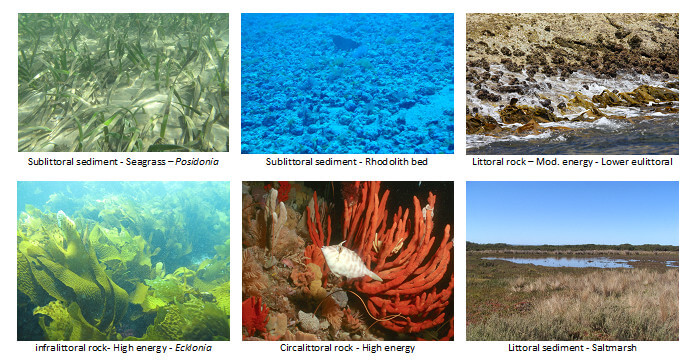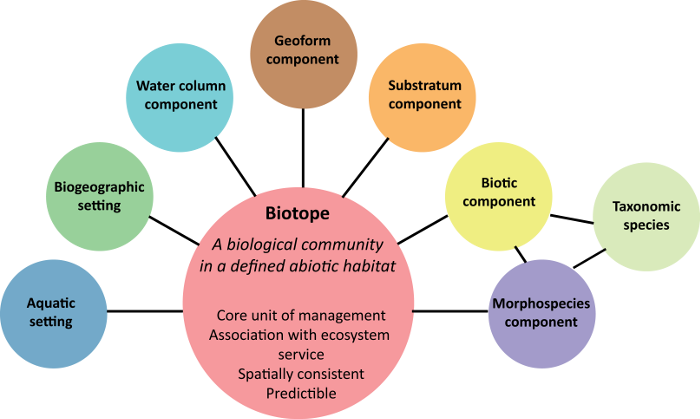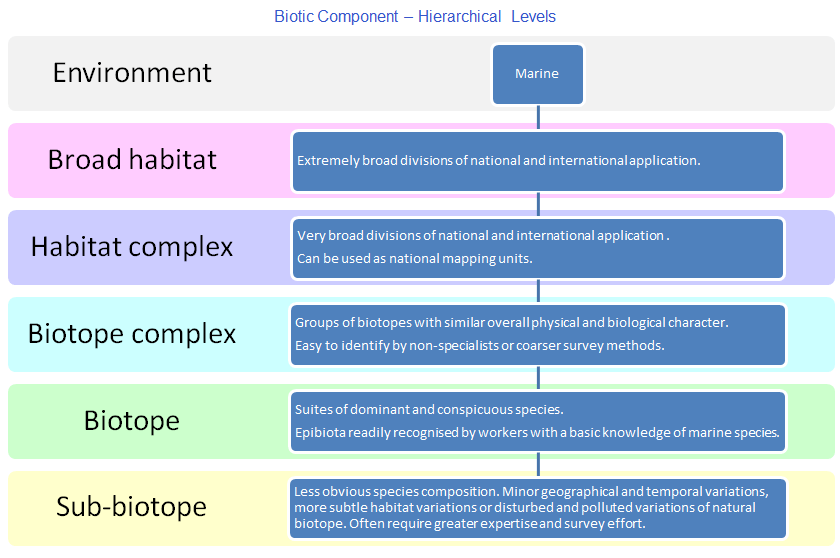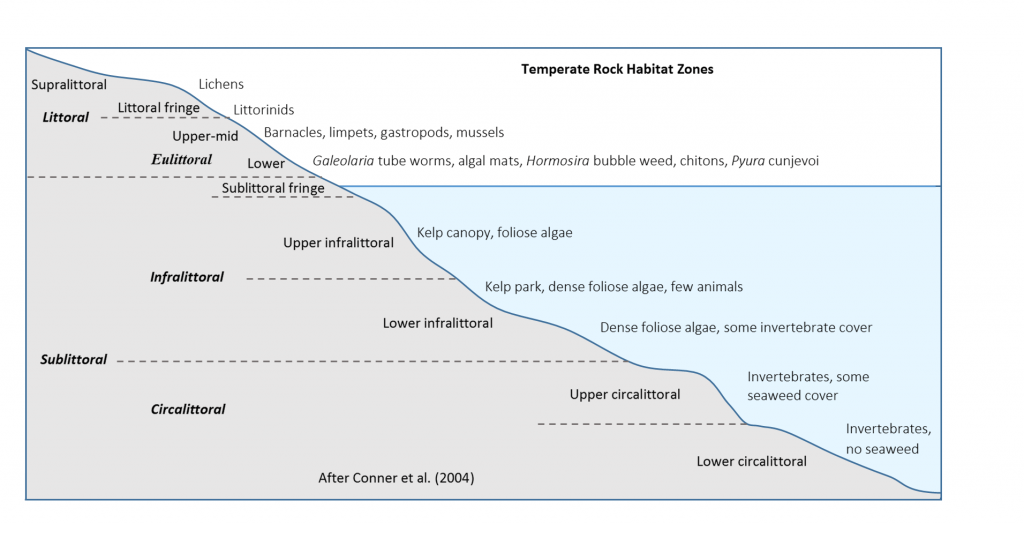The biotic component is the central component of CBiCS, classifying biological communities that are in a defined habitat. Key design features of the biotic component include:
- Provide a unified system for classifying biotopes in all marine and coastal habitats.
- Provide objective classes suitable for mapping.
- Provide classes for long-term monitoring and reporting of community states and succession.
- Consistency with the European-based JNCC / EUNIS biotope classification scheme.
- Consistency with terrestrial classification systems, including mangrove, saltmarsh and coastal ecological vegetation classes.

The concept of the biotope is central to CBiCS and is considered the desired unit of classification for ecological mapping and monitoring over time. As per the JNCC / EUNIS system, a biotope is defined as a biological community or species assemblage that is consistently associated with a particular habitat. The CBiCS biotopes are similar to standardised terrestrial vegetation classes in that they are directly suitable for environmental and natural resource management and conservation. The biotic component structure is tightly integrated with the hierarchical classes of the other CBiCS components.

Biotic Hierarchy
There are six hierarchical levels for the biotic component, matching the JNCC / EUNIS levels:
Environment – e.g. marine
Broad habitat – e.g. infralittoral rock
Habitat complex – e.g. high energy infralittoral rock
Biotope complex – e.g. kelp with cushion fauna
Biotope – e.g. Alaria esculenta assemblages
Sub-biotope – e.g. Alaria esculenta and Laminaria digitata assemblage

The higher, broad-scale levels of the biotic component are divided by substratum types, habitat depth zones and energy level. Major divisions based on substratum type include hard rock, soft sediments, coral reef, ice and pelagic habitats. The rock and sediment habitats are divided into depth zones following those of JNCC, with the major marine zones being littoral (intertidal), infralittoral (shallow subtidal including seaweed habitats), circalittoral (deeper subtidal including sponge gardens) and deep circalittoral or offshore habitats. Rocky or hard substrata are divided into three energy levels, high moderate and low, with high energy habitats being exposed to ocean swells or very strong tidal currents and low energy habitats being sheltered from both swell action and strong currents.

Level 1 – Environment
The top level follows the EUNIS separation of major environments such as marine (including estuarine), coastal, inland surface waters and other terrestrial classes.
Level 2 – Broad Habitat
Broad habitats in the marine environment are segregated at this level by substratum type (sediment, coral reef, ice, or rock and other hard substrata) and by habitat zones. These zones are principally: littoral; infralittoral; circalittoral; deep-sea bed; and pelagic water column. The littoral zone is defined as not being permanently inundated. The infralittoral zone is characterised as being dominated by macroalgae for temperate waters (i.e. the euphotic zone) and temperate circalittoral zone reefs are characterised by sessile invertebrates. The deep-sea bed is defined as being beyond the continental shelf. The supralittoral zone is encompassed within the coastal environment.
Level 3 – Habitat Complex
Rocky reef habitat complexes are characterised by energy level and sediments are characterised by sediment grain size and structure (which is a function of energy levels). Biogenic habitat structures, such as seagrass beds and shell reefs, also differentiate habitat complexes.
Level 4 – Biotope Complex
Biotope complexes are groups of community-level biotopes with similar physical and biological characteristics, grouping biotopes that occur similar spatial contexts. They are defined in the JNCC-EUNIS scheme as being relatively easy to identify by either a non-specialist or by coarser survey methods. Biotope complexes may also be characterised by salinity, tidal and wave exposure regimes and finer scale depth/height zonation. CBiCS places an emphasis on visible structural characteristics in defining biotope complexes.
Level 5 – Biotope
Biotopes are typically distinguished by the composition of conspicuous species. This includes both dominant species and low abundant but frequently occurring biotope ‘indicator’ species. It should be noted that species most important in identifying biotopes are often not the most abundant. For epibenthic classes, these should be readily recognised by observers with training in the marine species. Quantitative sampling is often required to identify sediment biotopes at this level. Where taxonomy is not easily recognised, or where species are undescribed, CBiCS promotes the use of the morphospecies component to qualitatively or quantitatively describe biotopes.
Level 6 – Sub-biotope
Sub-biotopes are often defined by less obvious differences in species composition and typically reflect more subtle species associations and geographical, temporal or environmental variations. These often require greater expertise and/or survey effort to identify and map.
Level 7 – Patches and Facies
For some community types, including temperate reef sponge gardens and tropical coral reefs, there is occassional need in extending the hierarchy to a finer-resolution biological facies level. This is useful where a sub-biotope is structured by a mosaic of distinctly different structures that are consistent with particular fine-level geoforms, for example: vertical walls, horizontal ledges and ledge edges of a temperate reef; or for mapping impact zones of a disturbed assemblages at or near the individual level. The use of fine-scaled biological facies is likely to become more prevalent with the use of new stereo imaging and robotics mapping systems. These systems can efficiently map biota at the individual and patch/facies scale across large areas.
Biotic Hierarchy Explorer
The biotic component hierarchy can be explored by clicking here.
Adaptations from CMECS and JNCC
The CBiCS biotic component is based on principles from both the CMECS and JNCC-EUNIS schema. An advantage of CMECS is that it is designed to be applied to any marine situation, including unexplored and undescribed habitats. In contrast, the JNCC-EUNIS system is closed and designed explicitly for the known biotopes of Europe. A limitation of CMECS is that the biotic component is restricted to higher level structural features and does not resolve down to the biotope and assemblage levels.
An advantage of CMECS is the use of structural morphological features for defining biotic groups and this approach was adopted for the CBiCS biotic component. This was supported further in CBiCS by including a new morphospecies component, which is structured in accordance with the biotic hierarchy. Elements of the CMEC biotic component were included within the CBiCS morphospecies component.
The JNCC-EUNIS hierarchy was discovered to have wider applicability outside Europe and this structure was reflected in CBiCS. The system is explicitly scaled into ecologically meaningful habitat divisions, each group containing similar physical habitats and the biotopes within them. This has the advantage that each class or group carries a large amount of implicit information of the types of habitats and biological communities present.
Key CBiCS Distinctions
- CBiCS provides a biotope classification that is strongly hierarchical and based on an existing system with proven application.
- CBiCS provides a biotope classification that has equivalency with a terrestrial systems of classification (e.g. Australian ecological vegetation classes) that are enshrined in environmental management instruments, therefore providing a bridge to agency uptake.
- CBiCS incorporates environments that were not included in the original JNCC-EUNIS scheme such as coral reef habitats, drawing on a considerable body of existing classification.
- CBiCS provides a unified catalogue, database and user tools for the management and application of the classification scheme, rather than simply provide a new list of devised classes.
- CBiCS integrates a morphospecies classification scheme for describing biotopes.
